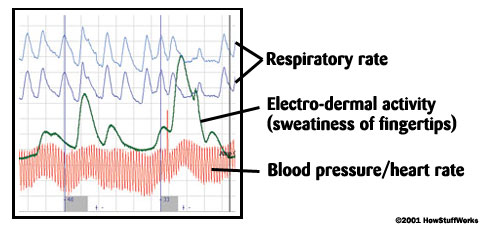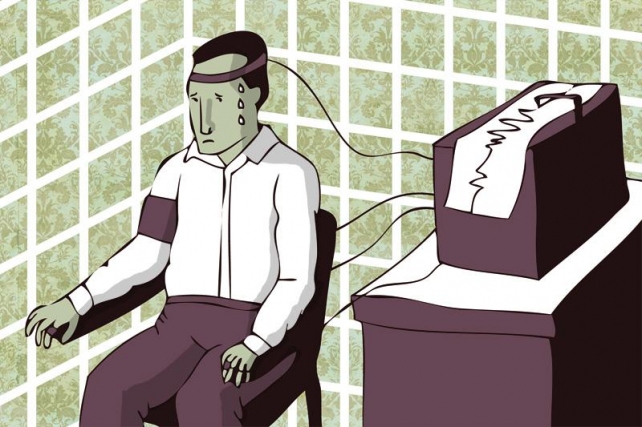General
This page gives a general overview of the polygraph.
Basic Information

howstuffworks.com
Polygraphs are popularly referred to as lie
detectors because they are designed to determine whether or
not a person is being truthful when asked a series of
questions. Polygraphs measure and record several physiological
indicators such as blood pressure, heart pulse, respiration,
and skin conductivity. The belief is that when a person
answers a question deceptively, the polygraph will produce
different measurements than if the person told the truth
(Rosenfeld).
Testing Procedure

wikihow.com
The examiner starts the polygraph session with a preliminary
interview, gaining information in order to develop diagnostic
questions for later. The examiner then explains how the
polygraph works, asserting that it can detect lies so the
subject should answer truthfully. Then the subject is asked to
deliberately lie so the examiner can be sure the polygraph is
working properly. Then the examiner begins the main testing
process.
Some of the questions are considered irrelevant or IR; the
examiner will ask the subject questions that are obvious in
order to have polygraph data to compare the other question
responses to. An example of an irrelevant question might be
"Are you sitting down right now?" Another type of question is
called diagnostic questions; the examiner will ask the subject
questions that may be uncomfortable for the subject to answer.
An example of a diagnostic question might be "Have you ever
seriously though about harming another individual?" The rest
of the questions are relevant questions or RQ; the examiner
will ask the subject questions that the examiner actually
wants to know the answer to. An example of a relevant question
might be "Did you murder Batman?"
The examiner alternates the type of question he/she asks the
subject. The answers are considered to be truthful if the
physiological responses to the relevant questions are smaller
than those during the diagnostic questions (Lewis).
In Japan, they use an alternative testing technique known as
the Quilty Knowledge Test (GKT), or the Concealed Information
Test (CIT). For this technique, the tester has no knowledge of
the crime or circumstances in question. The tester quizzes the
subject's knowledge of the crime that an innocent person would
not know. The tester may ask the subject "What type of weapon
was used to kill Batman?" then subject is given multiple
choices to choose from. They then tell the subject the correct
answer and monitor the subjects reaction with a polygraph. IF
the subject reacts strongly to the information, then the
subject likely knows facts relevant to the case (Polygraph
Procedures).
Validity

sdcitybeat.com
The validity of polygraph testing is widely debated and
criticized. There are a large number of cases that polygraphs
were proven to have thrown a false positive, incriminating an
innocent who "failed" the polygraph test.
It is argued that polygraphs are being used for measuring
human emotions, but there is simply no way, currently, to
measure human emotion. It is also argued that polygraphs
measure arousal, which can be caused by a great many things
such as anxiety, nervousness, fear, confusion, hypoglycemia,
psychosis, depression, substance induced, substance
withdrawal, or other emotions.
In addition, polygraphs accuracy has been known to be poor
when testing sex offenders with inadequate evidence to support
improved outcomes for cases in this population (Lewis).
Usage

cafepress.com
The United States is the biggest user of the polygraph,
specifically law enforcement and intelligence agencies.
Though a person's security clearance may not be revoked based
solely on a polygraph test's results, a person's access to
sensitive information may be denied if the test goes poorly.
Furthermore, some jobs in the government specifically require
successful completion of a polygraph test to be considered for
employment.
It is difficult to tell whether or not polygraphs are
effective at detecting spies, due to its validity issues.
However, it is still used as a deterrent to espionage,
"scaring straight" anyone that might consider it (Dedman).